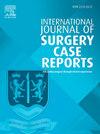A rare case of low-grade fibromyxoid sarcoma of the thigh: Diagnostic and therapeutic challenges in a resource-limited setting
IF 0.6
Q4 SURGERY
引用次数: 0
Abstract
Introduction and importance
Low-grade fibromyxoid sarcoma is a rare, indolent soft tissue tumor with a deceptively benign histological appearance, high recurrence rates, and potential for late metastasis. It typically arises in the deep soft tissues of the extremities or trunk in young adults, but reports of unusual locations exist.
Case presentation
We report a 43-year-old African male with a 2-year history of a progressively enlarging left thigh mass. Initial attempts at traditional remedies delayed medical intervention. Examination revealed a large ulcerated mass, and imaging showed a well-circumscribed soft tissue tumor without bone involvement. The biopsy confirmed Low-grade fibromyxoid sarcoma, and the patient underwent hip disarticulation surgery. Histopathology showed typical Low-grade fibromyxoid sarcoma features with no lymph node involvement. Postoperative recovery was satisfactory, and the patient is undergoing rehabilitation.
Clinical discussion
Low-grade fibromyxoid sarcoma diagnosis is challenging due to its morphological heterogeneity. Ancillary studies, including MUC4 immunostaining, are critical but often unavailable in resource-limited settings. Wide surgical excision remains the primary treatment, as the tumor is less responsive to chemotherapy and radiotherapy. This case underscores the need for early medical intervention, clinician-led community education, and long-term follow-up.
Conclusion
This report highlights the rarity of Low-grade fibromyxoid sarcoma and its challenges in resource-limited settings. Future efforts should focus on establishing standardized management protocols and identifying prognostic biomarkers to improve patient outcomes.
求助全文
约1分钟内获得全文
求助全文
来源期刊
CiteScore
1.10
自引率
0.00%
发文量
1116
审稿时长
46 days

 求助内容:
求助内容: 应助结果提醒方式:
应助结果提醒方式:


